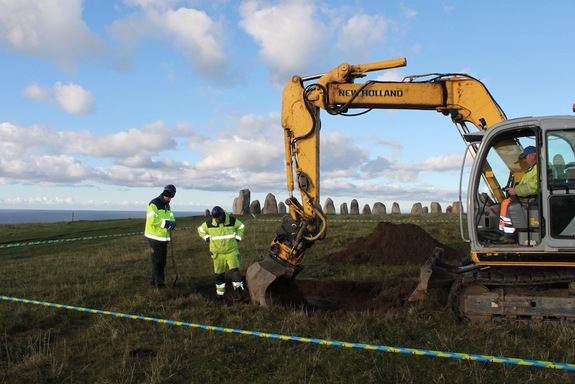Medieval History
On a promontory of land outside of the Swedish fishing town of Kaseberga, stand two rows of standing stones. A boat shaped burial monument, 220 feet (67m) long and composed of 59 megaliths that stand like sentinels guarding the cliffs and the pounding Baltic Sea below.?????
?

?????It is called the Ales Stenar, or Ales Stones, and much mystery surrounds it. There is local legend that claims it to be the burial site for the mythical King Ale - hence the name of the stones - and that he lays in his tomb beneath the Viking era ship monument.
Whatever the reason for its construction, it has stood there as it stands today. Over 1400 years old. Since the end of the Swedish Iron Age. But does it have a bigger tale to tell? Have modern archaeologists unravelled an even more ancient mystery at the Ales Stones?
Questions have long been asked of the stones and the reasons for them being there. Could they be older than Late Iron Age? Could they have been moved from somewhere else? An older site perhaps? And what is the cause and explanation of the distinctive cut marks that flaw the weathered surfaces of those massive 1800 kg (4000 lb) megaliths?
In 2006, archaeologists threw some of their modern resources at the monument. Using magnetic sensors and radar, they scanned beneath the Ales Stones and came up with a larger structure. A circle, 541 feet (165 m) in diameter, with a 65-foot by 25-foot rectangle in the centre.
Going forward in time to late October 2012, they finally dug a small trench at the site.
What they found rewrote the history of the stones and the history of the local area.
 While not finding a skeleton, they did discover the imprints of large boulders.. Giants which had been removed long ago and likely reused in the Viking Ship monument. The shape, the placement, suggested that the site was in fact a Neolithic site, with a burial chamber ? called a dolmen, which consisted of some upright boulders and a horizontal boulder under which a body would be placed ? most likely for a chieftain or neolithic clan chief and dating as much as over 5500 years ago.
While not finding a skeleton, they did discover the imprints of large boulders.. Giants which had been removed long ago and likely reused in the Viking Ship monument. The shape, the placement, suggested that the site was in fact a Neolithic site, with a burial chamber ? called a dolmen, which consisted of some upright boulders and a horizontal boulder under which a body would be placed ? most likely for a chieftain or neolithic clan chief and dating as much as over 5500 years ago.
Quite possibly, it is older than Stonehenge.
While they have some answers as a result of this dig, I think it is without doubt that the mysteries surrounding these amazing stones have only gotten deeper. The more ancient the site, the slower it will be at giving up its secrets.
- Vandals Threaten Medieval Castle In Wales
Medieval castle remains in Powys could be forced to close because of vandalism. People have damaged the structure of Bronllys Castle at Talgarth by throwing historic stones off the top, says Welsh monument agency Cadw. The castle only recently reopened...
- Archaeological Discoveries In Syria
Syrian archaeologists have discoverd cemetery dating back to the Roman era at the village of Ma'rin al-Jabal, southeast of the city of Hama in central Syria. According to a report in the Global Arab Network, Chairman of Hama Antiquities Department...
- By The River With 7th Graders, Mary Oliver, And Fafnir
There was an outing today. 150 kids, the entirety of the 7th grade, a drive out of our small town, and through Amish country to one of our glorious state parks. Warm, breezy, clear air redirected by cries of glee and teasing, kids running ahead, kids...
- Korrigans Now And Then
You truly never know where Brittany is going to take you next. We started the day by... making jam! I was the photographer, the girls stirred many things, and David was the orchestrator. Ten (!) jars of nectarine jams later, we were set - accomplished...
- Thoreau On Carnac
Thoreau, though he never left these American shores, wrote about Carnac! At this late hour, I can do little but happily quote favorite lines and revel in his own mixed emotions. He's traveling down the Concord and Merrimack rivers and he starts...
Medieval History
Those Old Grey Stones Aren't What They Used to Be
On a promontory of land outside of the Swedish fishing town of Kaseberga, stand two rows of standing stones. A boat shaped burial monument, 220 feet (67m) long and composed of 59 megaliths that stand like sentinels guarding the cliffs and the pounding Baltic Sea below.?????
?

?????It is called the Ales Stenar, or Ales Stones, and much mystery surrounds it. There is local legend that claims it to be the burial site for the mythical King Ale - hence the name of the stones - and that he lays in his tomb beneath the Viking era ship monument.
Whatever the reason for its construction, it has stood there as it stands today. Over 1400 years old. Since the end of the Swedish Iron Age. But does it have a bigger tale to tell? Have modern archaeologists unravelled an even more ancient mystery at the Ales Stones?
Questions have long been asked of the stones and the reasons for them being there. Could they be older than Late Iron Age? Could they have been moved from somewhere else? An older site perhaps? And what is the cause and explanation of the distinctive cut marks that flaw the weathered surfaces of those massive 1800 kg (4000 lb) megaliths?
In 2006, archaeologists threw some of their modern resources at the monument. Using magnetic sensors and radar, they scanned beneath the Ales Stones and came up with a larger structure. A circle, 541 feet (165 m) in diameter, with a 65-foot by 25-foot rectangle in the centre.
Going forward in time to late October 2012, they finally dug a small trench at the site.
What they found rewrote the history of the stones and the history of the local area.
Quite possibly, it is older than Stonehenge.
While they have some answers as a result of this dig, I think it is without doubt that the mysteries surrounding these amazing stones have only gotten deeper. The more ancient the site, the slower it will be at giving up its secrets.
- MM
- Vandals Threaten Medieval Castle In Wales
Medieval castle remains in Powys could be forced to close because of vandalism. People have damaged the structure of Bronllys Castle at Talgarth by throwing historic stones off the top, says Welsh monument agency Cadw. The castle only recently reopened...
- Archaeological Discoveries In Syria
Syrian archaeologists have discoverd cemetery dating back to the Roman era at the village of Ma'rin al-Jabal, southeast of the city of Hama in central Syria. According to a report in the Global Arab Network, Chairman of Hama Antiquities Department...
- By The River With 7th Graders, Mary Oliver, And Fafnir
There was an outing today. 150 kids, the entirety of the 7th grade, a drive out of our small town, and through Amish country to one of our glorious state parks. Warm, breezy, clear air redirected by cries of glee and teasing, kids running ahead, kids...
- Korrigans Now And Then
You truly never know where Brittany is going to take you next. We started the day by... making jam! I was the photographer, the girls stirred many things, and David was the orchestrator. Ten (!) jars of nectarine jams later, we were set - accomplished...
- Thoreau On Carnac
Thoreau, though he never left these American shores, wrote about Carnac! At this late hour, I can do little but happily quote favorite lines and revel in his own mixed emotions. He's traveling down the Concord and Merrimack rivers and he starts...
